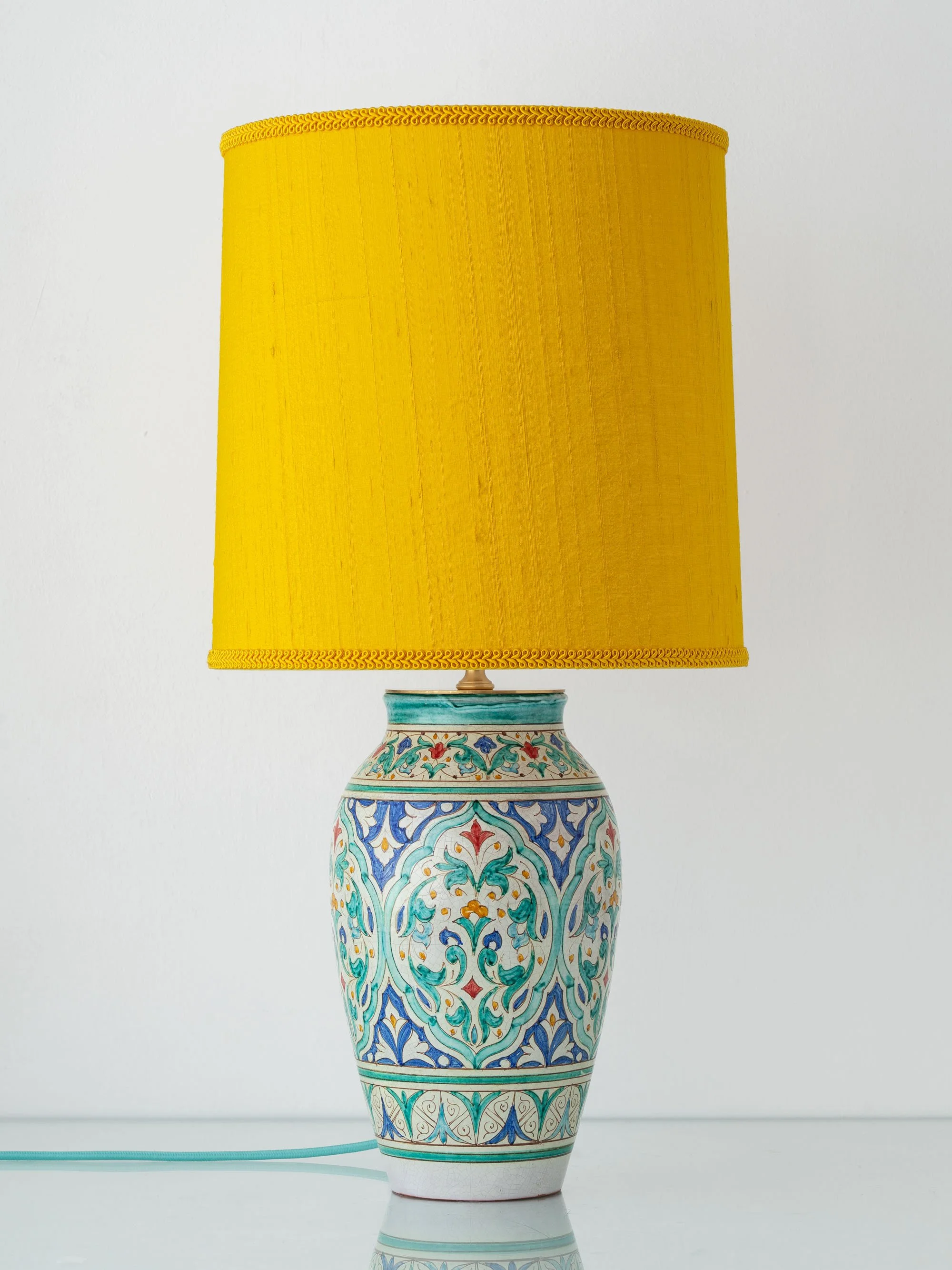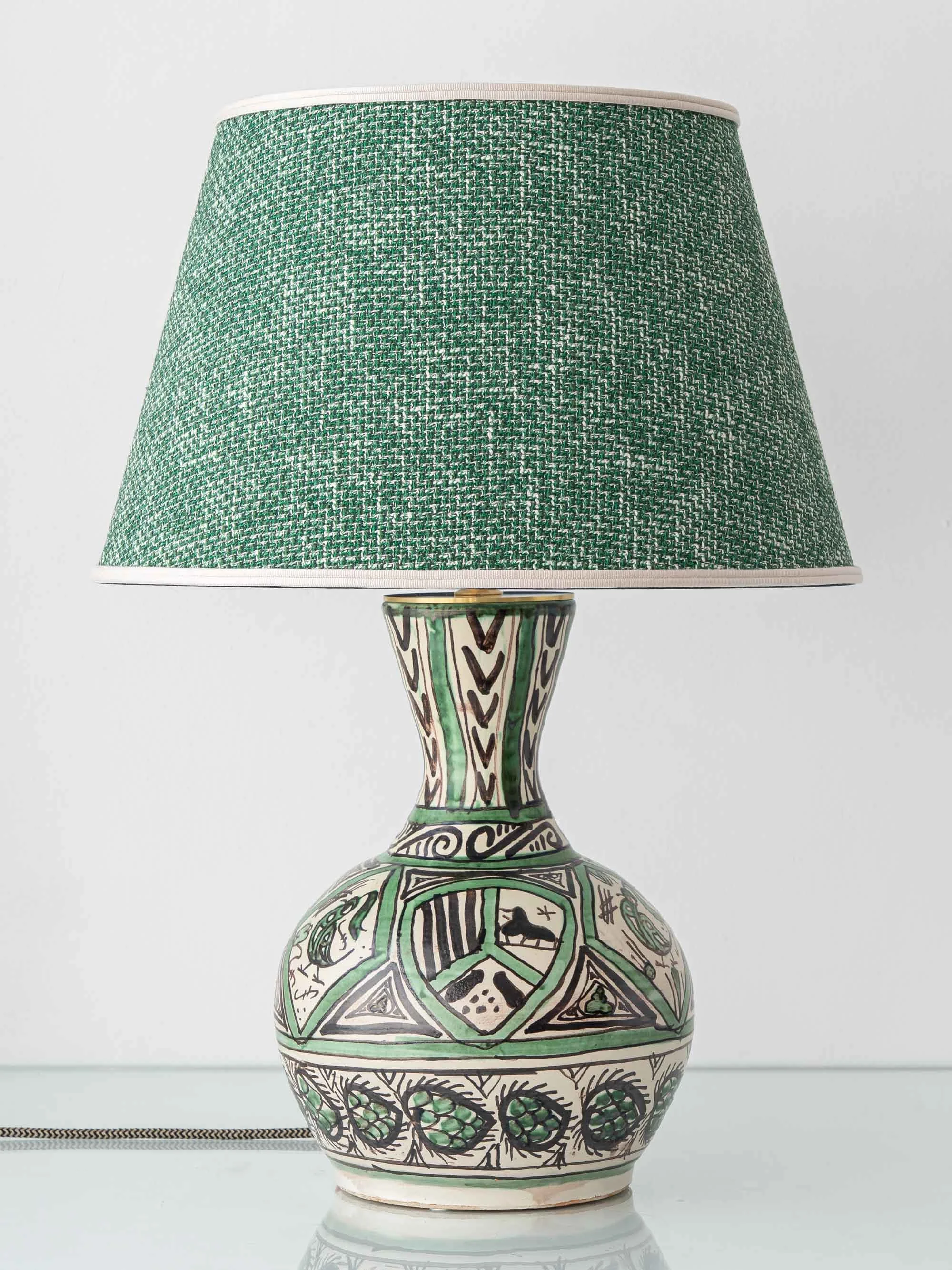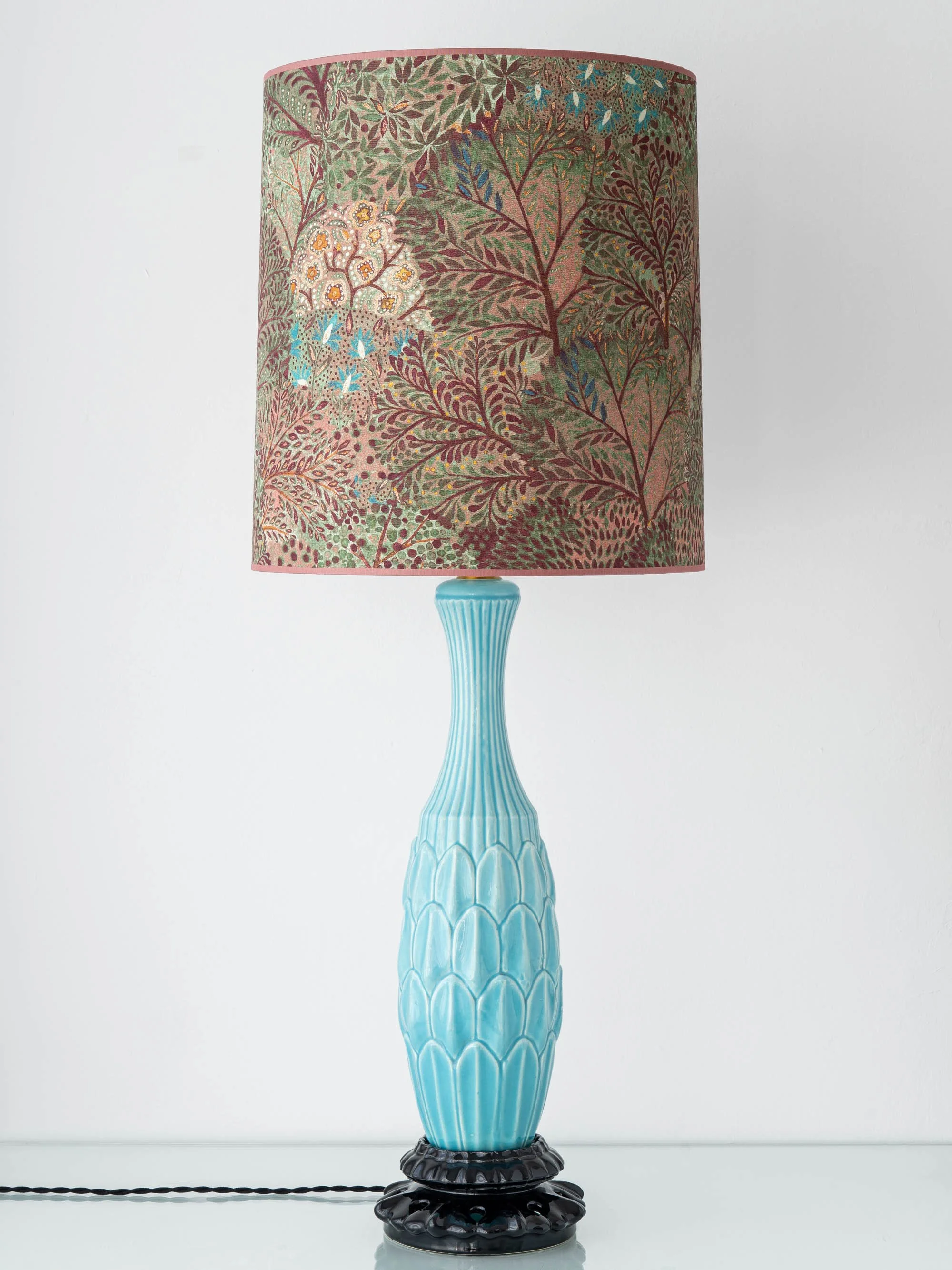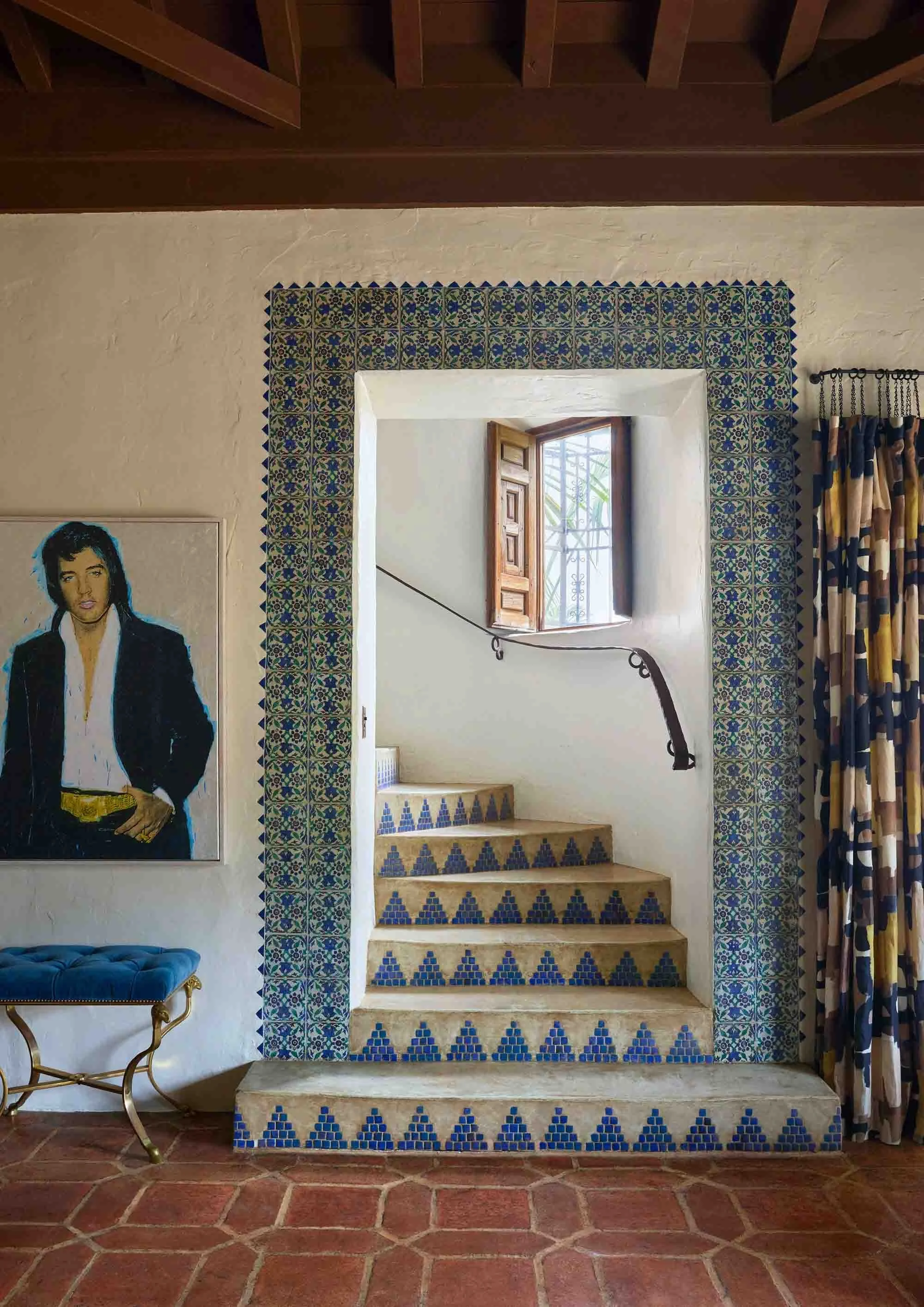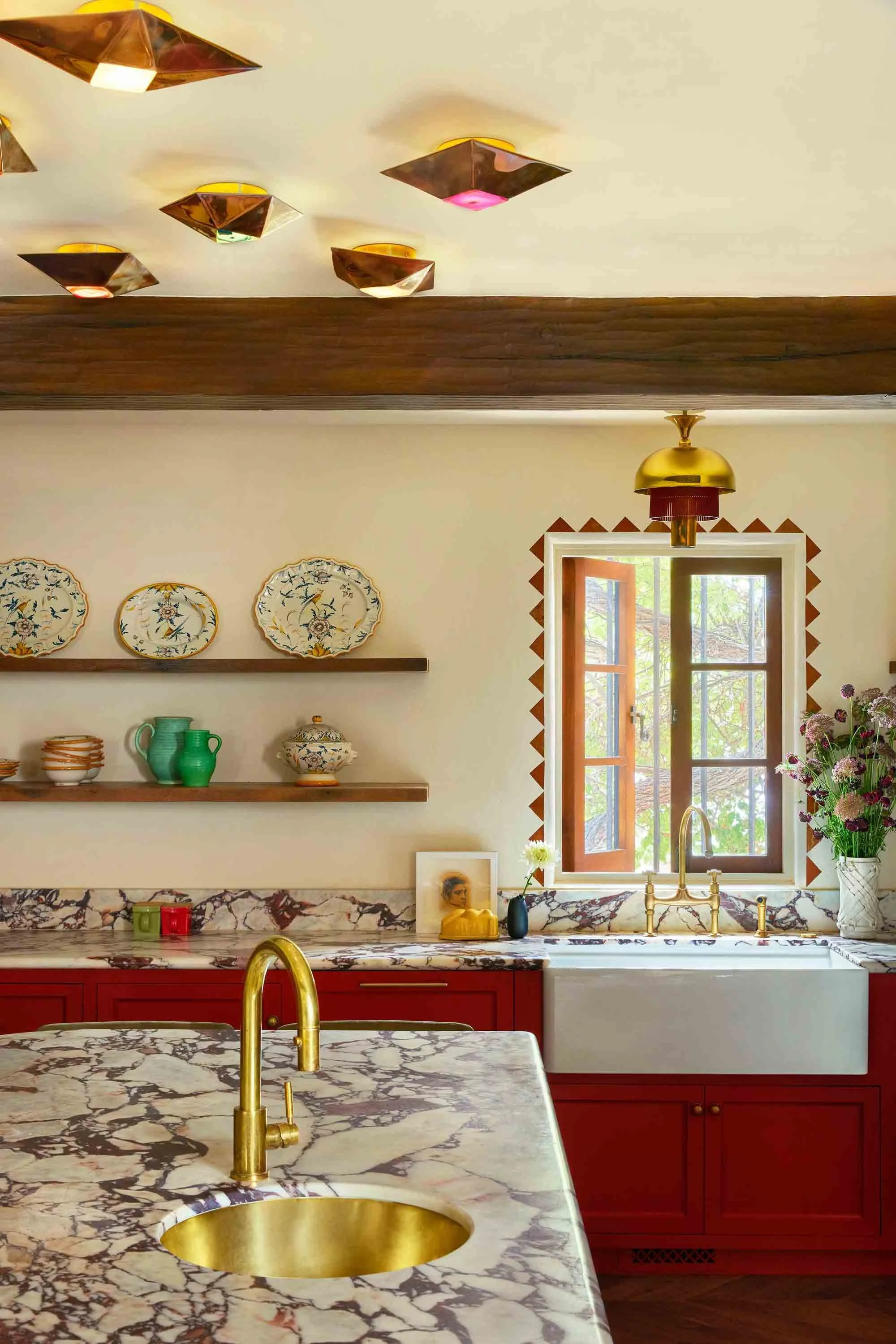The Missing Element in Spanish Revival Interior Design: Authentic Spanish Ceramics
A 1927 Spanish revival home on Las Palmas in Hancock Park, Los Angeles. Spanish Revival interior design by Noel Pittman, with antique Fajalauza ceramic lebrillos from Granada, Spain above the fireplace.
You've fallen for Spanish Revival architecture—the arched doorways, the hand-troweled plaster walls, the warmth of terracotta underfoot. Now comes the most rewarding part: bringing these rooms to life with objects that belong there.
This guide focuses on the single most authentic way to complete Spanish Revival interiors: Spanish ceramics. From understanding regional traditions to knowing exactly where to place pieces and where to find them in the first place, here's everything you need to create interiors as compelling as the architecture itself.
Not familiar with Spanish Revival architecture yet? Read our complete guide to Spanish style homes to understand the architectural foundation first.
Why Spanish Revival Interiors Need Ceramics (Not Just Any Decoration)
Spanish style villa home in Hancock Park, Los Angeles, with a living room that reflects the hallmarks of Spanish Revival interiors — timber beam ceilings, a white plaster fireplace with green tile, and vintage Fajalauza ceramic lebrillos from Granada, Spain. Design by Noel Pittman.
Walk through the great Spanish Revival homes—from Hancock Park to Montecito, Coral Gables to Santa Barbara—and you'll notice something. The most compelling interiors share more than architectural bones. They have objects that carry their own history and speak the same aesthetic language as the walls around them. More often than not, those objects are ceramic.
This isn't coincidental. Spanish ceramics and Spanish Revival architecture emerged from the same cultural moment—shaped by Moorish influences, regional craft traditions, and a Mediterranean sensibility that values handmade beauty over industrial perfection.
What Makes Spanish Ceramics Essential
Scale and presence. Spanish ceramic forms—lebrillos (large shallow bowls), tinajas (storage jars), botijos (drinking vessels)—were made for daily use but at architectural scale. A Fajalauza lebrillo might measure 18 inches across. A Manises lamp base can stand two feet tall. These aren't delicate tchotchkes. They have the visual weight to hold their own against timber beams and archways.
Color that complements the palette. The Spanish Revival palette is simple: white plaster, terracotta floors, dark wood beams, wrought iron, and strategic splashes of tile in blues, greens, and yellows. Spanish ceramics work in this exact color range. Cobalt blue and emerald green from Granada. Copper green and manganese black from Aragón. The vivid blues and whites of Galicia.
Handmade character that matches the architecture. Mass-produced objects feel wrong in Spanish Revival homes because everything else is so emphatically crafted. Hand-troweled plaster. Hand-forged iron. Individually laid tiles. Spanish ceramics match this quality. Brushstrokes are visible. Glaze pools slightly thicker in certain areas. Forms are confident but not machine-perfect.
Historical resonance. The architects who created Spanish Revival homes in the 1920s studied photographs of actual Spanish buildings—buildings that contained these ceramics. You're not imposing an aesthetic. You're completing the reference.
Understanding Your Canvas: Spanish Revival Architecture Essentials
Before discussing which ceramics to choose, it's worth understanding why Spanish Revival architecture creates such a perfect backdrop for them. (For the full architectural deep-dive, see our guide to Spanish style homes.)
Hedgerow Montecito Country House by Betsy Burnham Design — a Spanish Revival interior in Montecito, California, where arched plaster walls, terracotta floors, stair tiles, timber beams, and wrought iron details frame a double-height entry. Photography by Ye Rin Mok.
Plaster walls create the backdrop. Unlike flat drywall, traditional plaster has subtle texture and depth. Hand-troweled and slightly irregular, these matte white or cream surfaces diffuse light beautifully. They make colored ceramics absolutely sing. A cobalt blue Fajalauza jar against white plaster creates visual clarity no amount of styling can achieve on different surfaces.
Arches and niches do more than look romantic—they create natural opportunities for display. The curved opening frames whatever you place within it, turning a simple vase into a focal point. These are essentially built-in pedestals.
Terracotta floors ground everything. These earthy red-brown surfaces anchor the brightness of plaster walls and provide the perfect complement to glazed ceramics. The warm, matte earthiness makes glazed pottery feel precious by contrast.
Timber beams add structure without heaviness. Dark wood against white plaster creates rhythm. Against this backdrop, the vertical forms of ceramic vessels create natural visual balance.
The architecture invites ceramics because both traditions share certain qualities: handmade rather than mass-produced, rooted in regional craft, shaped by Islamic influences, built to last generations. A hand-painted Talavera lamp isn't an unrelated object imposed on the space—it speaks the same historical and aesthetic language as the walls.
A Curated Guide to Spanish Ceramic Traditions
Spain has produced ceramics in dozens of regional centers for centuries. Rather than catalog them all, this guide focuses on traditions that work most powerfully in Spanish Revival interior design—the ones you're most likely to find and the ones with the strongest visual impact.
Andalusia: Bold Color & Moorish Heritage
Fajalauza (Granada)
Hand-painted Fajalauza ceramic tiles from Granada, Spain — crafted in the Albaicín following centuries-old Andalusian traditions. These glazed azulejos in blue, green, and yellow preserve Granada’s artisanal heritage. Photo by Carlos Bullejo for Elle Decor España.
f you know one Spanish pottery tradition, it's probably this one. Made in Granada since the 16th century, Fajalauza pottery is instantly recognizable: white tin glaze painted with cobalt blue and emerald green in patterns of pomegranates (Granada's symbol), birds, vines, and foliage.
The color combination—blue and green on white—is both bold and harmonious. Against white plaster, it creates crisp visual clarity. Next to timber beams or terracotta, it adds cool contrast without clashing.
Why it works in Spanish Revival interiors: Large Fajalauza pieces, especially lebrillos (those shallow wide bowls), are particularly prized.
A lebrillo displayed above a fireplace mantel or on a long console table becomes an instant focal point—large enough to read across a room, beautiful enough to draw you closer.
Where it belongs: Kitchens (where lebrillos were originally used), living rooms (displayed as art), bathrooms (as functional vessels), dining rooms (as serving pieces). The style is bold without being overwhelming, traditional without being stuffy.
Al Yarrar (Granada)
For those who respond to geometric precision, Al Yarrar represents a different aspect of Andalusian heritage.
This contemporary studio in Granada's Albaicín quarter revives Nasrid design traditions—the intricate mathematical patterns that cover the walls of the Alhambra.
Al Yarrar ceramics feature interlacing stars, arabesques, and repeating geometric motifs painted with architectural precision.
In Spanish Revival interiors, these pieces echo the geometric tile work you might find on stair risers or fountain surrounds.
Where it belongs: More formal rooms—dining rooms, libraries, entryways—where their complexity can be appreciated.
Aragón: Graphic Strength
Detail of Mudéjar architecture on the tower of the Church of El Salvador in Teruel, Spain — part of the UNESCO World Heritage Site “Mudéjar Architecture of Aragón.” This 12th-century style blends Islamic tradition with Gothic influences, using intricate brickwork and glazed ceramic tiles.
Punter (Teruel)
Teruel , in northeastern Spain, developed a distinctive Mudéjar ceramic tradition during the Middle Ages. The palette was strict: copper green and near-black manganese over white glaze. The motifs were bold: stylized birds, geometric bands, simplified foliage, all rendered with confident, graphic linework.
The Punter family workshop has continued this tradition for five generations, making vessels that carry the same visual energy as pottery made six centuries ago—but unmistakably shaped by contemporary hands.
Why it works: Punter ceramics offer something different from the more delicate Fajalauza style. They're bolder, more graphic, with stronger contrasts. A large Punter jar can anchor a bookshelf or console table with serious presence. The green-and-black palette reads clearly against plaster and works especially well with dark wood and wrought iron details.
When to use it: If your space feels too sweet or too soft, Punter ceramics add strength without heaviness.
Galicia: Folk Energy Meets Modern Form
Sculptural botijos (drinking jugs) by Sargadelos, contemporary porcelain ceramics that reinterpret the traditional Spanish botijo with bold cobalt blue and white geometric patterns, a distinctive hallmark of Galician ceramic design.
Sargadelos
Sargadelos ceramics look unlike anything else in Spain. Founded in the early 19th century and reimagined mid-20th century, Sargadelos developed a distinctive style: vivid cobalt blue patterns—Celtic spirals, local symbols, abstracted botanical motifs—on brilliant white porcelain.
The work feels both folkloric and modernist, rooted in Galician heritage but formally bold and contemporary.
Why it works: In Spanish Revival interior design, Sargadelos adds energy. The cobalt blue echoes Fajalauza and traditional Spanish tiles, so it feels contextually appropriate—but the graphic quality and modernist clarity make it feel fresh. Use Sargadelos when you want color, pattern, and personality without historicism.
Regal (Alfonso Otero Regal)
For those drawn to studio ceramics and sculptural forms, Alfonso Otero Regal's work represents contemporary Galician pottery at its most experimental.
Based in Viveiro, Regal creates pieces that blur the line between vessel and sculpture—asymmetrical, textured, boldly decorated, sometimes described as Picasso-esque.
These aren't traditional decorative objects. They're closer to art.
In Spanish Revival interiors, they add a contemporary note—a reminder that Spanish ceramic traditions didn't end in the 18th century but continue evolving.
Where to place: On a pedestal, in a niche, on a fireplace mantel where it can be appreciated as form.
Valencia: Sculptural Lighting
Manises Lamps
Just outside Valencia, the town of Manises has been a ceramic center since the Middle Ages, famous for Hispano-Moresque lusterware. But it's the mid-20th century that produced one of Manises's most distinctive contributions: ceramic table lamps.
These weren't minimalist modern designs—they were exuberant, sculptural, handmade, and glazed in every color imaginable. Mediterranean blues, deep greens, rich turquoises, warm ochres. Bases might be curving or geometric, smooth or heavily textured, decorated with applied elements or incised patterns.
For decades, these lamps were forgotten—dismissed as old-fashioned, often discarded when estates were cleared. But the craft is now being revived. Studios like Can Betelgeuse, led by ceramicist Danae Marín, are rescuing Manises lamp-making traditions before they disappear entirely.
How do you add distinctive lighting without resorting to reproduction fixtures or generic modern designs? A handmade ceramic lamp brings craft, color, and sculptural interest—and it provides the warm, diffused light Spanish Revival rooms were designed for.
Vintage Manises Ceramic Table Lamp with Liberty London Lampshade by Amitābha Studio
Amitābha Studio also specializes in transforming antique and vintage Spanish ceramics into one-of-a-kind table lamps. Each piece pairs authentic ceramics with custom wiring and bespoke lampshades—heritage pieces reimagined as functional lighting. These aren't reproductions. They're museum-quality ceramics given new life. Browse the collection →
Where to place: Side tables, consoles, nightstands. Let them be focal points rather than afterthoughts.
Lladró
While Lladró is globally known for porcelain figurines, the house also produces vessels, vases, and lighting defined by luminous whites, sculptural profiles, and precise glazing. Founded near Valencia in 1953, Lladró represents the refined, elegant end of Spanish pottery tradition.
Why it works: In Spanish Revival interior design, Lladró pieces bring lightness and clarity—a counterpoint to earthier terracotta and rustic timber. A white Lladró vase on a dark wood console, catching afternoon light from a nearby window, creates a moment of quiet sophistication.
Where it belongs: Dining rooms and bedrooms, where you want beauty without visual noise.
Other Notable Traditions
Talavera de la Reina deserves mention as one of Spain's most important ceramic centers, recognized by UNESCO. Talavera majolica is painterly, colorful, and exuberant—effective in kitchens, dining rooms, and anywhere bold pattern feels appropriate. Nearby Puente del Arzobispo produces earthier, more rustic ceramics with folk motifs.
In Catalonia, La Bisbal d'Empordà has long produced utilitarian pottery—amphorae, jars, and storage vessels in earthy reds, greens, and ochres. These work beautifully in kitchens and dining rooms, bringing functional beauty.
How to Style Spanish Revival Interiors with Ceramics
Understanding ceramic traditions is one thing. Placing them well in your home is another. The goal isn't to create a museum or follow rigid rules—it's to let the architecture guide you while trusting your own eye.
Spanish tiled archway, Montecito. Interior design by House of Honey.
Fundamental Principles
Go bigger than you think. The most common mistake is choosing ceramics that are too small. Spanish Revival interiors have volume—high ceilings, substantial proportions, generous wall space. A six-inch vase will disappear. A twenty-inch jar will register.
Specific guidance: For rooms with 10-foot ceilings, choose pieces 18-24 inches tall. For 8-foot ceilings, 14-18 inches. Console tables over 60 inches wide can handle pieces 16-20 inches in diameter. When in doubt, choose the larger piece.
Use architectural features. If your home has niches, place ceramics there. The architecture is already framing them. Fireplace mantels, console tables beneath mirrors, and bookshelves with open space all invite ceramics.
Consider sightlines. Place important pieces where they'll be seen from multiple vantage points. An entry console works because you see it walking in and again moving through adjacent rooms. A dining sideboard gets viewed from the table.
Think about light. Glazed ceramics are different objects in different light. Natural light brings out color depth and makes glazes glow. Place your best pieces near windows during the day, or add dedicated lighting for evening drama.
Vintage Spanish ceramics displayed in kitchen. Interior design by House of Honey.
Placement Strategy
The architecture tells you where ceramics belong:
Niches frame them perfectly—a single substantial piece becomes sculptural.
Fireplace mantels create natural gallery walls: one large lebrillo centered, or three vessels of varying heights arranged asymmetrically.
Console tables beneath mirrors work best with grouped objects: a lamp on one side, a jar on the other, balanced but not matched.
Built-in bookshelves invite integration. Rather than filling every shelf with books, leave strategic gaps for ceramics. The contrast between paper and glazed pottery creates visual rhythm.
Entry consoles set the tone. This is where guests form first impressions. A statement lamp or an extraordinary lebrillo announces that craft matters here. Keep it simple: one or two pieces maximum.
Dining rooms call for lighting. Manises lamps on a sideboard provide ambient light for evening meals. Their sculptural forms become conversation pieces. Add one large serving vessel and stop.
Bathrooms and bedrooms reward restraint. One beautiful piece—a vase in a niche, a lamp on a nightstand—creates intimacy without clutter.
Design by Noel Pittman
How Many Pieces?
Less than you think.
A typical living room only needs two or three significant ceramic pieces—a pair of lamps and a large jar, or three vessels of varying heights on a console. Spanish Revival interior design is about quality and presence, not quantity.
If you're just starting, begin with one excellent piece. Live with it for a while. See how it changes the room. Notice where your eye wants more—and where it doesn't. Build slowly. These objects should feel inevitable, not impulsive.
Mixing Eras & Traditions
One of the most appealing aspects of Spanish ceramic tradition is its continuity. You can mix 18th-century antique Talavera with contemporary Sargadelos, vintage Manises lamps with newly made Fajalauza-style pieces. They share enough aesthetic DNA to work together.
Antique pieces bring patina, history, and gravitas—glaze might be crazed, edges slightly chipped. These imperfections make a room feel collected over time rather than decorated all at once.
Vintage mid-century ceramics, especially Manises lamps and Sargadelos porcelain, add sculptural boldness and period-appropriate design.
Contemporary work from studios like Can Betelgeuse, Al Yarrar, and Regal proves the tradition is alive, keeping a room from feeling like a period recreation.
Reimagined antiques—vintage ceramic vessels transformed into lamps—offer a perfect middle path. You get the patina and authenticity of antique ceramics with the functionality of modern lighting.
Color Considerations
Spanish pottery offers a natural color palette that works harmoniously with Spanish Revival architecture:
Blues (cobalt, navy, cerulean) contrast beautifully with warm terracotta and timber while complementing white plaster.
Greens (emerald, olive, copper-green) echo the landscape and provide earthy, grounded color.
Whites and creams create breathing room and sophisticated simplicity.
Polychrome pieces from Talavera or Sargadelos bring maximum color and pattern—use these sparingly as focal points.
Manganese black in Punter ceramics adds graphic contrast and reads as almost neutral.
You don't need to match everything. Different ceramic traditions can coexist if they share some color or formal qualities.
A cobalt blue Sargadelos plate and an emerald green Fajalauza jar don't match, but they belong together—both bold, both hand-painted, both rooted in Spanish tradition.
Where to Find Authentic Spanish Ceramics
Antique Granada Fajalauza Ceramic Lebrillos
For authenticated antiques and rare pieces: Sotheby's, Christie's, 1stDibs, Chairish, and Pamono offer curated selections of Spanish ceramics from vetted dealers and auction houses.
For contemporary pieces from traditional Spanish workshops: Can Betelgeuse, Al Yarrar, Punter, and Sargadelos produce newly made ceramics that carry forward regional craft traditions.
For museum-quality antique ceramic lamps: Amitābha Studio specializes in transforming vintage and antique Spanish, Delft, and ceramic vessels into one-of-a-kind table lamps—each piece combining authentic historical ceramics with custom wiring and carefully selected shades. Explore the collection →
In Spain itself: Most exceptional Spanish ceramics—especially antiques and vintage pieces—are found in Spain, not online. Granada's Albaicín quarter has studios and antique shops specializing in Fajalauza pottery. Valencia and nearby Manises offer both contemporary ceramic workshops and vintage finds. Barcelona's Els Encants flea market and Carrer de la Palla antique dealers carry museum-quality pieces. Madrid's El Rastro (Sunday market) and Nuevas Galerías galleries reward patient hunting. Seville and Córdoba have smaller workshops preserving Andalusian traditions. Visiting the source regions means accessing pieces rarely exported—and understanding the craft firsthand. Consider it research. Or the perfect excuse for a trip.
How to Build Your Collection
Start with lighting. A pair of exceptional lamps provides both function and beauty. This makes the investment feel practical as well as aesthetic.
Add one large statement piece. A substantial jar, lebrillo, or sculptural vessel. This should be your "wow" piece—something people notice immediately.
Fill in with smaller pieces over time. Plates, bowls, smaller vases. These are where you can experiment with different regions and styles.
Don't rush. Spanish Revival interiors should feel collected over time, not decorated in a single shopping spree. Buy what genuinely moves you, live with it, then add thoughtfully.
Hedgerow Montecito House by Burnham Design. Spanish ceramics styled in a Spanish Revival dining room. Photo by Ye Rin Mok
FAQ About Spanish Revival Interior Design
What is Spanish Revival interior design?
Spanish Revival interior design refers to styling homes built in the Spanish Revival architectural style (1915-1940s) with period-appropriate furnishings, materials, and decorative objects. It emphasizes handcrafted elements, natural materials like wood and iron, Spanish ceramics, and a restrained color palette that complements the architecture's plaster walls, timber beams, and terracotta floors.
How do I decorate a Spanish Revival home?
Start with quality over quantity. Use authentic materials (wood, iron, ceramics, natural textiles), choose pieces with appropriate scale for the room's proportions, place objects where the architecture invites them (niches, mantels, consoles), and favor handmade Spanish ceramics that share the architecture's craft values and historical roots.
What colors work in Spanish Revival interiors?
The foundation is white/cream plaster, terracotta floors, and dark wood beams. Accent with cobalt blue, emerald green, ochre yellow, and warm terracotta—the same palette found in traditional Spanish tiles and ceramics. Avoid overly bright or synthetic colors.
Where can I buy authentic Spanish pottery?
Antique pieces: specialized dealers (1stDibs, Chairish), European auction houses, Spanish flea markets. Contemporary: directly from Spanish workshops like Can Betelgeuse, Al Yarrar, Punter, and Sargadelos. Reimagined antique ceramic lamps: Amitābha Studio specializes in transforming antique vessels into functional lighting.
Can I mix different Spanish ceramic traditions?
Yes. Different traditions can coexist if they share some color or formal qualities. A cobalt Sargadelos plate and emerald Fajalauza jar work together because both are bold, hand-painted, and rooted in Spanish tradition. The key is shared aesthetic DNA, not exact matching.
What's the difference between Spanish Revival and Spanish Colonial Revival?
The terms are often used interchangeably. "Spanish Colonial Revival" emphasizes direct references to Spanish Colonial architecture. "Spanish Revival" casts a slightly wider net including Moorish and Andalusian influences. Both refer to the same 1915-1940s American architectural movement inspired by Spanish precedents.






